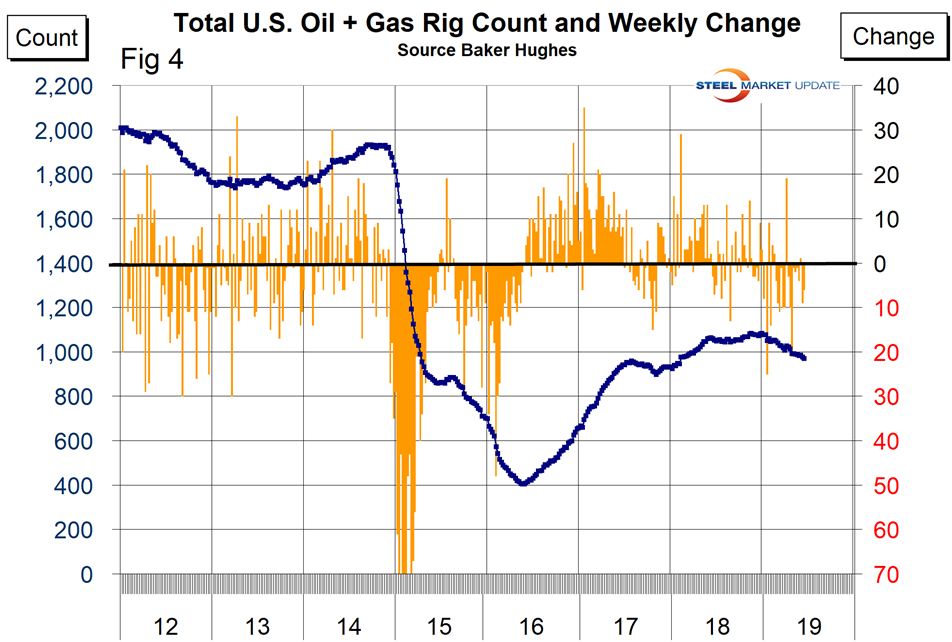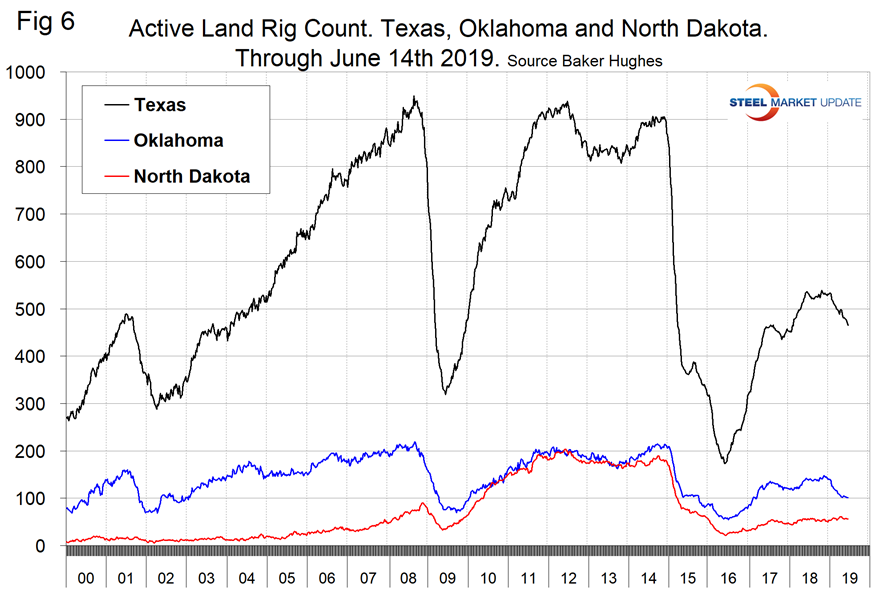Market Data

June 21, 2019
SMU Energy Analysis: Rig Count Declines
Written by Peter Wright
The spot price of West Texas Intermediate (WTI) FOB Cushing, Okla., reached $66.24 per barrel on April 20 and had declined to $51.94 on June 17. The total number of operating rigs exploring for oil has declined by 106 since Jan. 4. The prices of oil and natural gas drive the consumption of energy-related steel products including oil country tubular goods, pipe fittings and well head equipment, among others. Welded tubular goods (not including OCTG) consumed about 5.5 million tons of hot rolled sheet in 2018.
![]()
Figure 1 shows historical oil and gas prices from January 2000 through June 17, 2019. Our price and inventory data come from the Energy Information Administration (EIA). On June 14 (latest data available), natural gas at the Henry Hub in Oklahoma was priced at $2.41 per MM BTU, down from $3.50 on Jan. 25.
The EIA short-term energy forecast of June 11 stated that Brent crude oil spot prices averaged $71 per barrel (b) in May, largely unchanged from April 2019 and almost $6/b lower than the price in May of last year. However, Brent prices fell sharply in recent weeks, reaching $62/b on June 5. EIA forecasts Brent spot prices will average $67/b in 2019, $3/b lower than the forecast in last month’s STEO, and remain at $67/b in 2020. EIA’s lower 2019 Brent price path reflects rising uncertainty about global oil demand growth.

On June 14, the EIA reported that U.S. commercial crude oil inventories (excluding those in the Strategic Petroleum Reserve) declined by 3.1 million barrels from the previous week, but were up by 40.6 million barrels from this time last year. Figure 2 shows the inventory level, including the strategic petroleum reserve and the year-over-year change.

Figure 3 breaks total crude inventory into the working portion and the strategic petroleum reserve.

The total number of operating rigs in the U.S. on June 14 was 969, down by 106 since Jan. 4. Oil rigs were down by 89 and gas by 17. Figure 4 shows the total number of operating rigs in the U.S. and the weekly change.

The oil rig count had a low point of 316 on June 27, 2016, and stood at 788 on June 14, 2019.
The U.S. gas rig count rose from its low point of 81 on Aug. 5, 2016, to 181 on June 14, 2019. The year-over-year growth rate of total U.S. operating rigs was negative 8.5 percent in the latest data with oil down by 8.7 percent and gas down by 6.7 percent. Figure 5 shows the Baker Hughes U.S. Rotary Rig Counts for oil and gas equipment in the U.S. (explanation below).

On a regional basis in the U.S., the big three states for operating rigs are Texas, Oklahoma and North Dakota. Figure 6 shows the land rig count in those states since 2000.

Figure 7 illustrates the monthly U.S. oilfield production of crude from January 1970 through March 2019 (latest data available) in thousands of barrels per month. The historical high was October 1970 at 310.4 million barrels. Production steadily declined to half that level in the late 2000s before the fracking revolution. December 2017 broke the record that had stood for 47 years with 310.7 million barrels produced and December 2018 set a new record at 370.8 million barrels. March 2019 at 369 million barrels saw a recovery from the 327 million barrels produced in February.
The EIA reported in their latest outlook that annual U.S. crude oil production reached a record 11.0 million b/d in 2018. EIA forecasts that U.S. production will increase by 1.4 million b/d in 2019 and by 0.9 million b/d in 2020, with 2020 production averaging 13.3 million b/d. Despite EIA’s expectation for slowing growth, the 2019 forecast would be the second-largest annual growth on record (following 1.6 million b/d in 2018), and the 2020 forecast would be the fifth-largest growth on record.

Figure 8 compares oil production and the oil rig count and shows how the increase in exploratory wells drove production from 2009 through late 2014 when the oil price collapsed. Rig count and production have declined in synchrony in 2019.

Baker Hughes Rotary Rig Count: This is a weekly census of the number of drilling rigs actively exploring for or developing oil or natural gas in the United States. Rigs are considered active from the time they break ground until the time they reach their target depth. The Baker Hughes Rotary Rig count includes only those rigs that are significant consumers of oilfield services and supplies.







